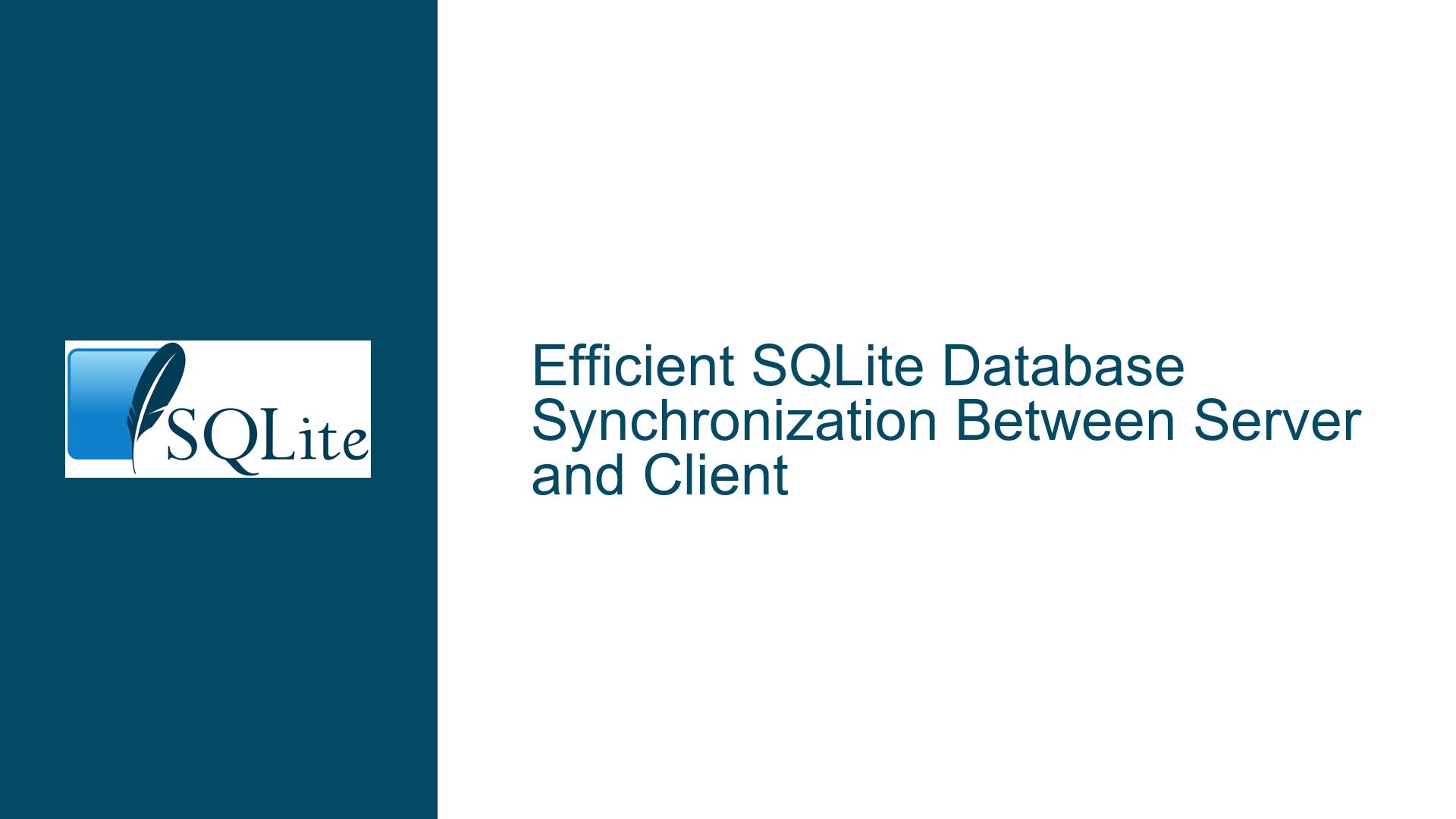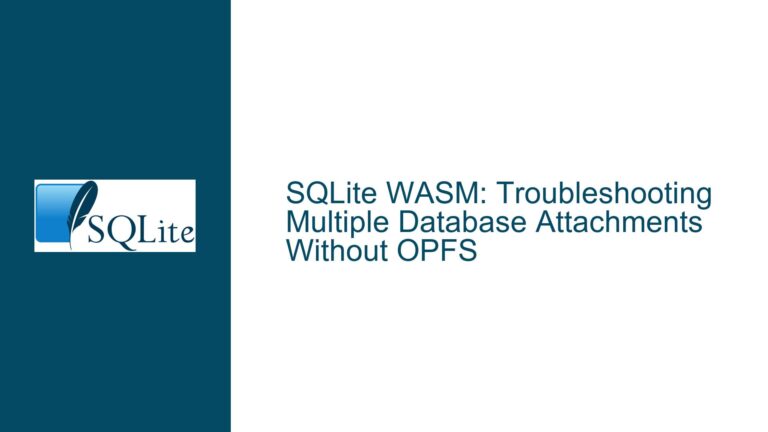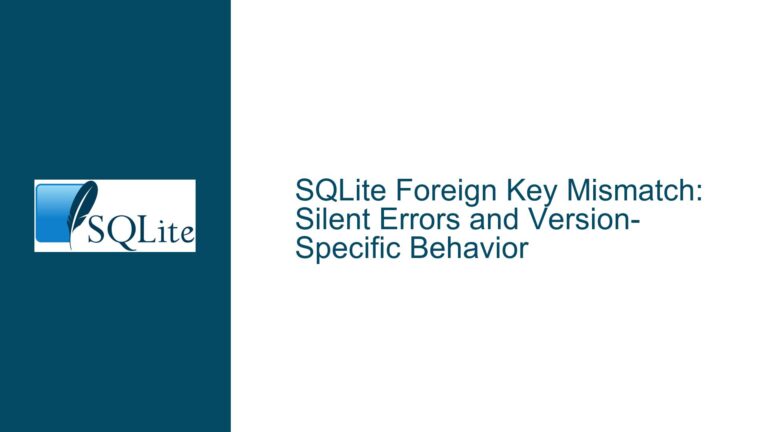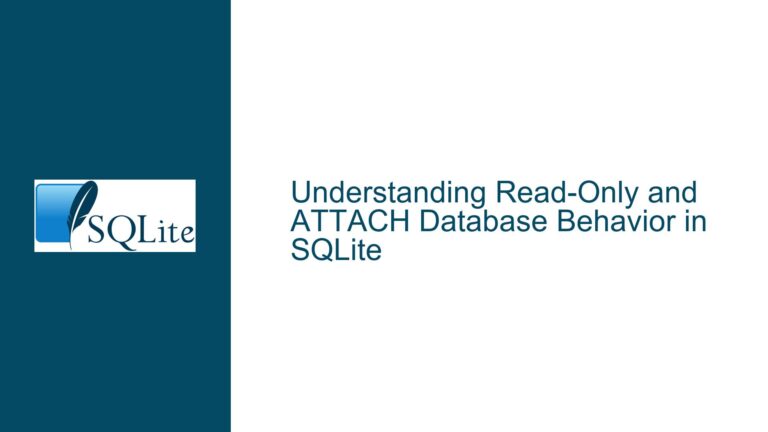Efficient SQLite Database Synchronization Between Server and Client
Using dbhash for Synchronization and Its Limitations
The core issue revolves around synchronizing SQLite databases between a server and a client application. The primary method under consideration is the use of SQLite’s dbhash utility to detect changes and trigger synchronization. The dbhash program generates a hash of the database’s content, which can be used to quickly determine if the client’s database is out of sync with the server’s. However, while this method is efficient for detecting changes, it does not inherently provide a mechanism for syncing the actual data. This leads to the question of how to efficiently transfer only the necessary changes (inserts, updates, and deletions) from the server to the client without transferring the entire database file.
One proposed solution involves fetching the entire database file from the server when a mismatch in dbhash is detected. While this approach is straightforward, it may not be efficient for larger databases or frequent updates. Additionally, this method does not address how to handle deletions or complex updates that may require more granular synchronization. The challenge lies in designing a system that can detect changes at a fine-grained level and transmit only the necessary data to the client, ensuring that both databases remain consistent without unnecessary data transfer.
Potential Risks of Raw SQL Query Synchronization
Another approach discussed in the thread is the idea of passing raw SQL queries from the server to the client to bring the client’s database in sync. While this method might seem simple, it introduces several risks and complexities. First, executing raw SQL queries on the client side can be dangerous if not properly sanitized, as it opens the door to SQL injection attacks. Second, this approach assumes that the client and server databases are structurally identical, which may not always be the case. Differences in schema versions or customizations could lead to errors or data corruption when executing raw SQL queries.
Moreover, raw SQL synchronization does not inherently handle deletions or complex transactions that involve multiple tables. For example, if a record is deleted on the server, simply executing an INSERT or UPDATE query on the client will not reflect this change. This method also lacks a built-in mechanism for conflict resolution, which is crucial in scenarios where both the client and server might have made changes to the same data independently. Therefore, while raw SQL synchronization might work in simple scenarios, it is not a robust solution for more complex synchronization needs.
Log-Based Synchronization with Rowid Tracking
A more sophisticated approach involves maintaining a log of SQL commands executed on the server and using this log to synchronize the client’s database. This method entails creating a log table on the server that records every INSERT, UPDATE, and DELETE operation. Each log entry is assigned a unique rowid, which can be used to track the progress of synchronization. The client stores the rowid of the last log entry it has processed, and during each synchronization cycle, it fetches only the new log entries from the server and applies them to its local database.
This approach offers several advantages. First, it allows for granular synchronization, as only the changes since the last sync are transmitted to the client. Second, it naturally handles deletions, as the log will include DELETE commands that the client can execute to remove records. Third, it provides a mechanism for conflict detection and resolution. By storing the last processed rowid on both the server and client, the system can detect discrepancies that might arise from restoring old backups or other anomalies. If the rowid on the client does not match the expected value on the server, the synchronization process can halt and alert the user, preventing potential data corruption.
However, this method also introduces some complexities. The server must maintain a log table, which adds overhead to every write operation. Additionally, the log table must be carefully managed to prevent it from growing indefinitely. One solution is to periodically truncate the log table after all clients have synchronized up to a certain point. Another consideration is the handling of schema changes. If the server’s schema evolves over time, the log entries must be compatible with the client’s schema, or the synchronization process must include steps to update the client’s schema before applying the log entries.
Implementing a Hybrid Synchronization Strategy
Given the strengths and weaknesses of the approaches discussed, a hybrid strategy might offer the best balance between efficiency and robustness. This strategy could combine the use of dbhash for quick change detection with a log-based system for granular synchronization. Here’s how it could work:
Change Detection with dbhash: The client periodically fetches the server’s
dbhashand compares it to its own. If the hashes match, no synchronization is needed. If they differ, the client initiates a synchronization process.Log-Based Synchronization: The server maintains a log table that records all
INSERT,UPDATE, andDELETEoperations. Each log entry includes arowidand a timestamp. The client stores therowidof the last log entry it has processed.Fetching and Applying Changes: During synchronization, the client fetches all log entries with a
rowidgreater than its last processedrowid. It applies these changes to its local database, ensuring that deletions and updates are handled correctly.Conflict Detection and Resolution: Before applying the log entries, the client checks that its last processed
rowidmatches the expected value on the server. If there is a mismatch, the synchronization process halts, and the user is alerted to investigate potential issues, such as a restored backup or manual changes to the database.Schema Management: The system includes a mechanism for handling schema changes. When the server’s schema is updated, it generates a special log entry that instructs the client to update its schema before applying further changes. This ensures that the client’s database remains compatible with the server’s.
Log Maintenance: The server periodically truncates the log table to remove entries that have been processed by all clients. This prevents the log table from growing indefinitely and reduces the overhead of maintaining it.
This hybrid approach leverages the efficiency of dbhash for quick change detection while providing the granularity and robustness of a log-based system for synchronization. It addresses the limitations of each individual method and provides a comprehensive solution for keeping SQLite databases in sync between a server and client.
Conclusion
Synchronizing SQLite databases between a server and client involves balancing efficiency, robustness, and complexity. While the dbhash utility provides a quick way to detect changes, it does not offer a mechanism for granular synchronization. Raw SQL query synchronization, while simple, introduces significant risks and limitations. A log-based approach, combined with rowid tracking, offers a more robust solution but requires careful management of the log table and schema changes.
A hybrid strategy that combines dbhash for change detection with a log-based system for granular synchronization provides the best of both worlds. It ensures efficient and accurate synchronization while minimizing the risk of data corruption or conflicts. By implementing such a strategy, developers can create reliable and scalable systems for keeping SQLite databases in sync across multiple clients and servers.






